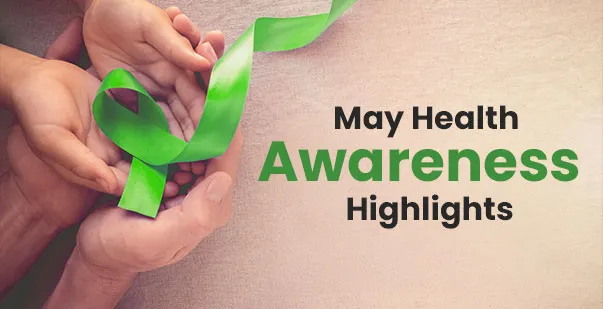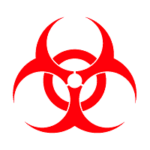May has a special kind of energy. The weather’s warmer, flowers are blooming and everywhere you turn, people are talking about health. Over 78% of adults now recognize that mental health matters as much as physical health, according to IPSOS Global Advisor. That’s just one example of the growing shift in how we view well-being.
Observed since 1949, Mental Health Awareness Month now reaches millions, sparking conversations that reduce stigma and encourage healing. But mental health is just the start. May also shines a spotlight on skin cancer prevention, asthma, allergies, and physical fitness, each campaign pushing us to take personal steps toward better health.
This month is a reminder that health is personal, and awareness drives action. So, what exactly is May bringing to the table? Let’s take a closer look.
Why Health Awareness Months Matter
Over 200 health awareness observances are recognized annually in the United States, covering a wide range of health issues from the most common to the rarest. Health campaigns often go unnoticed until they hit close to home. Health awareness months turn quiet issues into national conversations. They educate, empower, and push us toward healthier choices, one campaign at a time. Here’s why they’re more important than ever:
Early Detection Saves Lives
One of the biggest impacts of health observance campaigns is encouraging people to get checked early. According to the American Academy of Dermatology, when melanoma is caught in its earliest stages, the five-year survival rate is about 99%. Campaigns like Skin Cancer Awareness Month help spotlight the importance of regular self-checks and screenings, which can make the difference between life and death.
Breaking The Stigma
Awareness leads to understanding and that reduces shame. Campaigns like Mental Health Awareness Month give people the words and confidence to talk about what they’ve been quietly dealing with. With over 57.8 million adults in the U.S. living with a mental illness, these campaigns help bring much-needed visibility and reduce isolation among those affected.
Take the example of a working mom who always thought feeling low was just something you had to “push through.” Then one day, she saw a post on LinkedIn about mental health struggles after motherhood. It hit home. She finally opened up to her doctor, and that one conversation led her to real help and healing.
These kinds of awareness efforts also matter where we spend most of our time: in schools and at work. Wellness workshops, peer groups, and mental health days are starting to become more common, and they’re slowly changing how we think about care and support.
Therapy is becoming easier to access, too. From video calls with licensed therapists to mental health apps and even AI tools that guide you through therapy-style exercises, help is now just a few taps away.
Empowering Communities
When health campaigns are done right, they bring people together, from local groups to national organizations. Events like fitness challenges and awareness months make it easier for everyone to learn about staying healthy in fun and practical ways. Take National Physical Fitness and Sports Month, for example. It’s not just about going to the gym, it’s about getting more people moving in whatever way works for them. And it’s working. According to the 2025 Topline Participation Report from the Sports & Fitness Industry Association (SFIA), 247.1 million Americans were active in 2024. That’s 80% of the population, and it’s up by over 25 million people since 2019.
These numbers reflect real-life action at the community level. Health clinics have been setting up free screenings and info booths. Schools are organizing walk-to-school days. Offices are turning daily steps into friendly team competitions. These grassroots efforts make health education feel less like a lecture and more like something people want to join.
Inspiring Long-Term Habits
Awareness events often act as a springboard for change. Simple challenges, like walking 30 minutes a day, can lead to reduced blood pressure, better mental health, and improved heart health. The Centers for Disease Control and Prevention (CDC) notes that 150 minutes of moderate physical activity a week can lower the risk of chronic illnesses such as diabetes and heart disease.
Federal and local campaigns have made a real impact in getting Americans to walk more. One big effort, the CDC’s Step It Up! Call to Action launched in 2015, inspired programs like Walk With a Doc. A survey from that year showed that over 92% of participants felt more informed about the benefits of walking, and nearly 80% said they were exercising more. In Ottawa County, Michigan, an 8-week walking challenge in 2016 got 854 people to join, logging over 106,000 miles together. Seniors alone logged more than 179,000 minutes of physical activity.
Fitness apps, step trackers, and social media challenges like “Move It May” make it easier to stay on track and celebrate small wins along the way.
The Big Themes of May: Health Observances You Should Know
May is a powerhouse month for health awareness. Historically, May has been chosen for multiple public health campaigns because it marks a seasonal shift, people are more active, outdoors, and focused on self-care as summer approaches. This makes it an ideal time to spotlight a wide range of health topics that affect individuals and communities globally. These observances offer an opportunity to educate, raise awareness, and take action on issues that affect individuals and communities globally. From mental health to blood pressure, May is a month to focus on well-being in all its forms. Let’s see some of the key health observances in May and what they mean for public health.
1. Mental Health Awareness Month
Mental Health Awareness Month, observed throughout May, is one of the most critical health observances of the year. With the growing prevalence of mental health conditions around the world, this observance is an opportunity to shed light on mental health issues, reduce stigma, and encourage people to seek the support they need.
According to the National Alliance on Mental Illness (NAMI), 1 in 5 adults in the United States experiences a mental illness in any given year, and 1 in 25 adults live with a serious mental illness such as schizophrenia, bipolar disorder, or major depression. Furthermore, suicide is the 10th leading cause of death in the U.S., and mental health disorders are one of the leading contributors to that statistic. In 2023, NAMI’s campaign #TaketheMoment encourages people to embrace the power of now and recognize that all people are worthy of love, support, and help, just as they are.
Key Themes:
- Reducing stigma and discrimination related to mental illness
- Encouraging people to seek professional help
- Promoting mental health resources and support groups
- Supporting mental health in workplaces, schools, and communities
Why It’s Important:
Mental health is just as important as physical health. Mental illnesses are among the leading causes of disability worldwide, and many individuals struggle with these conditions without proper support. Mental Health Awareness Month serves as a reminder to take care of both our minds and bodies and seek help when needed.
What You Can Do This Month:
- Schedule a mental health check-in using free online screening tools like mhascreening.org.
- Join a virtual or local event during Mental Health Action Day (May 16, 2024).
- Wear orange to support Skin Cancer Awareness during Melanoma Monday (May 6).
- Join a fitness challenge, physical activity supports mental health too.
- Donate to mental health organizations or support a crisis hotline.
- Thank a healthcare hero during Nurses Week (May 6–12).
- Start a conversation about mental health at home, work, or school.
- Share the message on social media using hashtags like #MoreThanEnough and #MentalHealthAwarenessMonth.
2. National Physical Fitness and Sports Month
May is also National Physical Fitness and Sports Month, a time to highlight the importance of physical activity for maintaining good health. The observance encourages individuals of all ages to engage in regular physical exercise, emphasizing that exercise isn’t just for athletes; it’s a vital component of a healthy lifestyle for everyone.
More people today are embracing digital fitness options. From using apps to track daily steps to joining 30-day fitness challenges on social media, staying active has become more accessible than ever, right from home. These tools have also helped people stay connected and motivated, especially during remote work or recovery periods. Moreover, exercise is shown to reduce symptoms of anxiety and depression and boost overall mood, making it one of the most effective non-medication approaches to mental health.
According to the Centers for Disease Control and Prevention (CDC), only 23% of Americans meet the recommended guidelines for aerobic and muscle-strengthening activity. The CDC also highlights that regular physical activity can reduce the risk of developing chronic conditions such as heart disease, diabetes, and obesity.
This month also brings attention to programs designed for different age groups. Many schools organize “walk to school” weeks and short activity breaks between classes to get kids moving. For older adults, community centers often host low-impact activities like chair yoga or group walks to help them stay active safely. No matter your age or fitness level, there’s always a way to move a little more and feel a lot better.
Key Themes:
- Encouraging regular physical activity for all age groups
- Highlighting the physical and mental benefits of exercise
- Promoting sports as a fun way to stay active and healthy
- Educating communities about how to incorporate fitness into daily routines
Why It’s Important:
Exercise boosts overall health, enhances mood, and increases energy levels. It reduces the risk of developing chronic diseases and is essential for managing existing conditions. By making fitness a priority in May, we can create a foundation for healthier, longer lives.
3. High Blood Pressure Education Month
May is also recognized as High Blood Pressure Education Month. High blood pressure, also known as hypertension, affects millions of people worldwide, yet many are unaware that they have it. High blood pressure is often called the “silent killer” because it typically has no symptoms, but if left untreated, it can lead to severe health complications, including heart disease, stroke, kidney failure, and more.
The CDC reports that about 119.9 million Americans have high blood pressure. However, only about 1 in 4 people with high blood pressure have it under control. During High Blood Pressure Education Month, health organizations aim to educate the public about the risks associated with hypertension and encourage regular blood pressure screenings.
Key Themes:
- Promoting the importance of regular blood pressure monitoring
- Educating the public about the dangers of high blood pressure
- Encouraging lifestyle changes such as healthy eating, regular exercise, and stress management
- Providing resources for managing and lowering blood pressure
Why It’s Important:
High blood pressure is a major risk factor for heart disease and stroke, two of the leading causes of death globally. Keeping an eye on your blood pressure at home is simple and one of the best steps you can take for your heart health. Home monitors are easy to find at pharmacies or online. They’re affordable, and doctors often recommend them for regular check-ins between appointments. You can use an automatic cuff-style monitor that wraps around your upper arm, not your wrist or finger. Sit comfortably, rest your arm on a table, and avoid caffeine or exercise for 30 minutes beforehand. Try to take your reading at the same time every day and write it down in a log. This helps you and your doctor spot patterns over time.
And here’s a helpful tip: most pharmacies now offer free blood pressure checks, no appointment necessary. So even if you don’t have a monitor at home, it’s still easy to stay on top of your numbers.
Quick Dietary Tips for Lowering Blood Pressure:
What you eat has a big impact on your blood pressure. One of the most trusted approaches is the DASH diet (Dietary Approaches to Stop Hypertension). It focuses on healthy, whole foods, like fruits, vegetables, whole grains, and low-fat dairy, that naturally support a healthy heart. In addition, try to limit your sodium intake to under 2,300 mg per day. Cut back on processed foods, frozen meals, salty snacks, and sugary drinks, which often contain hidden sodium.
To balance things out, add more potassium-rich foods to your plate, such as bananas, spinach, sweet potatoes, beans, and avocados. These help your body manage sodium and ease pressure on your blood vessels.
4. Asthma and Allergy Awareness Month
May is also Asthma and Allergy Awareness Month, a time to recognize the impact of asthma and allergies on millions of people worldwide. According to the American College of Allergy, Asthma, and Immunology (ACAAI), asthma affects more than 24 million people in the United States alone, and allergies are the most common chronic condition in the country, affecting 1 in 5 people. Springtime, especially May, often brings peak pollen levels, which can exacerbate asthma and allergy symptoms. Trees like birch and oak, along with grasses such as Bermuda and Kentucky bluegrass, release significant amounts of pollen during this period.
Thus, asthma is broken down into allergic asthma, which is triggered by allergens such as pollen, dust mites, or pet dander and non-allergic asthma, which is induced by factors like stress, exercise, or cold air. Similarly, allergies themselves can be categorized into food allergies, which are reactions to specific foods like nuts or shellfish and environmental allergies, which are responses to pollen, mold, or pet dander.
This observance educates the public about the symptoms, triggers, and treatment options for both asthma and allergies. It also raises awareness about the importance of managing these conditions effectively to improve quality of life.
Key Themes:
- Educating the public about asthma and allergy triggers, such as pollen, dust, and pet dander
- Providing information about the latest treatment options and medications
- Encouraging people with asthma and allergies to create action plans for managing their conditions
- Promoting better indoor and outdoor air quality
Why It’s Important:
Asthma and allergies can significantly impact daily life, particularly during peak allergy seasons. According to the ACAAI, asthma is responsible for more than 10 million doctor visits and 900,000 emergency room visits annually in the U.S. Understanding how to manage these conditions can help individuals live more comfortably and reduce the risk of asthma attacks or allergic reactions. An effective asthma action plan includes details on daily and emergency medications, recognizing and avoiding factors that worsen symptoms and guidelines on what to do during an asthma attack.
In addition, advancements like biologic therapies (e.g., Dupixent) offer new treatment avenues for moderate-to-severe asthma. Additionally, digital tools like smart peak flow monitors help patients track their lung function and manage symptoms proactively.
5. Healthy Vision Month
Healthy Vision Month is observed every May to raise awareness about the importance of eye health. With increased screen time in our daily lives, digital eye strain has become a common issue. The month focuses on educating individuals about how to take care of their eyes and the importance of regular eye exams in detecting conditions such as glaucoma, macular degeneration, and diabetic retinopathy.
As per CDC, more than 3.4 million Americans age 40 and older are blind or have low vision. Yet, many vision problems can be prevented or treated if caught early. During Healthy Vision Month, the CDC encourages people to get regular eye exams and adopt healthy habits to protect their eyesight.
Combating Digital Eye Strain
With screen time increasing in our daily lives, many people experience digital eye strain, symptoms like dry eyes, blurred vision, and headaches. To reduce discomfort, follow the 20-20-20 rule: every 20 minutes, look at something 20 feet away for 20 seconds. This gives your eyes a much-needed break. Also, don’t forget to blink regularly, it helps keep your eyes moist and comfortable. Adjusting your screen’s brightness and using blue light filters can also reduce strain and make long hours in front of a screen easier on your eyes.
Eye Exam Recommendations
Regular eye exams are important at every age. Children should have their first eye exam between 6 to 12 months old, another between ages 3 to 5, and then yearly after they start school. Adults are advised to get an eye exam every 1 to 2 years, or as suggested by their eye care provider. These routine checks can help catch vision problems early and ensure long-term eye health.
Key Themes:
- Promoting eye health through regular eye exams
- Educating the public about common vision problems and how to prevent them
- Highlighting the connection between eye and overall health
- Raising awareness about the risks of digital eye strain
Why It’s Important:
Vision problems are one of the leading causes of disability worldwide. According to CDC, approximately 6 million Americans have vision loss, and 1 million have blindness. Many individuals suffer from preventable conditions because they neglect their eye health. By prioritizing vision care, individuals can ensure that they maintain good eyesight well into their later years. AI-based retinal screening tools, like EyeArt, are revolutionizing early detection of conditions such as diabetic retinopathy, ensuring timely treatment.
6. National Stroke Awareness Month
National Stroke Awareness Month, observed in May, brings attention to the importance of recognizing stroke symptoms, acting quickly, and reducing the risk of stroke. The risk is increasing among younger adults, often due to lifestyle factors like smoking and poor diet. A stroke occurs when blood flow to part of the brain is blocked or interrupted. It is one of the leading causes of death and disability worldwide, with someone in the U.S. having a stroke every 40 seconds, according to the CDC.
During this month, organizations such as the American Stroke Association promote awareness of the warning signs of stroke and encourage the public to seek immediate medical attention if a stroke is suspected. The month also focuses on educating individuals about the risk factors for stroke and how to reduce them through lifestyle changes, such as managing blood pressure, eating a healthy diet, and exercising regularly.
Key Themes:
- Recognizing the signs of stroke (Face drooping, Arm weakness, Speech difficulty, Time to call 911 – F.A.S.T.)
- Understanding stroke risk factors and prevention strategies
- Educating about stroke recovery and rehabilitation
- Encouraging a healthy lifestyle
Why It’s Important:
A stroke is a medical emergency that needs immediate treatment. Acting fast can save a life and help prevent serious long-term problems like paralysis or difficulty speaking. According to the CDC, nearly 140,000 people in the U.S. die from strokes every year.
Knowing the signs of a stroke and getting help right away can make a big difference. There’s something called the “golden hour”, the first hour after symptoms begin. If treatment is given quickly, especially within 3 to 4.5 hours, medicines like tPA (a clot-busting drug) can reduce the damage caused by a stroke and improve recovery. That’s why stroke awareness is so important. The more people know what to look for and how to respond, the more lives can be saved and the better the outcomes for stroke survivors.
7. National Nurses Week (May 6–12)
National Nurses Week celebrates one of the most trusted and essential professions in healthcare. From bedside care and patient education to public health and crisis response, nurses play a critical role in every corner of the healthcare system.
The week begins each year on May 6 and ends on May 12, the birthday of Florence Nightingale, the founder of modern nursing. It’s a time to recognize the dedication, compassion, and expertise that nurses bring to patients and communities every day.
Why It’s Important:
Nurses are often the first and last people a patient sees during a hospital visit. They work long hours, face emotional and physical demands, and continue to serve on the frontlines, especially during public health crises like the COVID-19 pandemic.
How You Can Celebrate:
- Thank a nurse with a handwritten note or small act of appreciation.
- Support local nursing programs or donate to a nursing scholarship fund.
- Share your gratitude online with hashtags like #ThankYouNurses and #NationalNursesWeek.
- Attend or promote community appreciation events for nurses.
- Advocate for policies that support better staffing, workplace safety, and mental health resources for nurses.
- This week is about showing nurses that their hard work and heart don’t go unnoticed, and that they are valued beyond measure.
- Hepatitis Awareness Month
May is also Hepatitis Awareness Month, a time to raise awareness about viral hepatitis, a group of infectious diseases that affect the liver. The most common types in the U.S. are hepatitis A, B, and C. These infections can range from short-term illness to long-term, serious liver damage, including cirrhosis, liver cancer, or even liver failure.
The CDC estimates that 300 million Americans are living with chronic hepatitis B or C, and many don’t know they have it. That’s because symptoms often don’t appear until the liver has already been damaged.
During this month, public health groups focus on prevention, testing, and treatment. Hepatitis can be prevented through vaccines (for hepatitis A and B) and careful practices like avoiding sharing needles or personal items that could be contaminated with blood.
Why It Matters:
Chronic hepatitis is often called a “silent epidemic.” Routine screening, especially for adults born between 1945 and 1965 or those with risk factors, can lead to early treatment and better outcomes.
Simple Steps You Can Take:
- Ask your doctor about hepatitis screening, especially if you’re at risk.
- Get vaccinated for hepatitis A and B if you haven’t already.
- Practice safer sex and avoid sharing needles or razors.
- Encourage loved ones to get tested and know their status.
- Spread awareness by sharing facts on social media using hashtags like #HepAware and #HepatitisAwarenessMonth.
How You Can Join the Movement
You don’t need to wear a lab coat to get involved in health observances! Here are a few ways to make a difference:
- Walk It Out: Join or start a walking group to promote fitness. It’s an easy way to get moving while raising awareness for physical health.
- Post with Purpose: Share health facts, personal stories, or messages using trending hashtags like #MentalHealthAwareness or #SunSafe to spread awareness on social media.
- Donate or Volunteer: Support a cause that resonates with you, whether it’s donating to a mental health organization or volunteering for local wellness events. Every effort counts.
- Host a Mini-Event: Organize a fun activity like a healthy bake sale, Zoom wellness session, or SPF awareness quiz to engage your community and raise awareness about health issues. Join initiatives such as NAMIWalks or free skin cancer screenings.
Remember, small actions can create big ripples. By taking part in these initiatives, you contribute to a larger movement of better health and well-being. Get involved, spread the word, and make a positive impact!
Take Action and Become a Life-Saver
May is the perfect time to take action and make a meaningful impact on health in your community. From walking to raise awareness, sharing vital health facts on social media, or hosting fun wellness events, every small step counts. But why stop there? Take your involvement to the next level by learning life-saving skills. Choose our certified BLS course online. It only takes a few hours, but the impact could last a lifetime. Don’t wait, sign up today!






